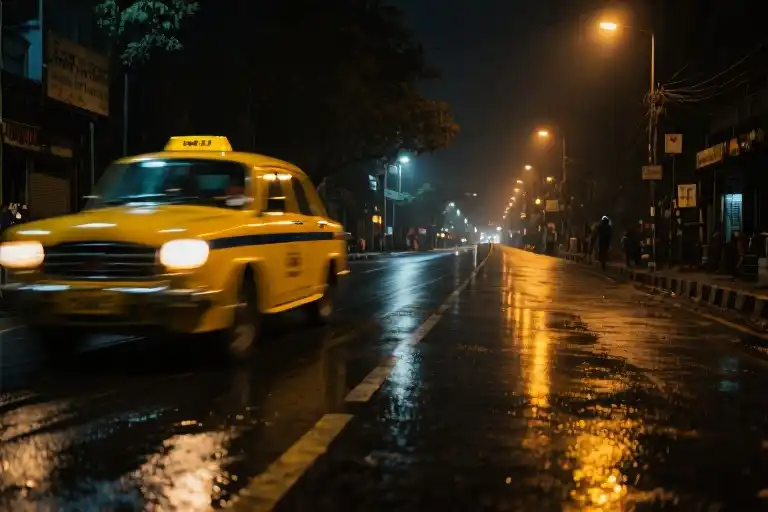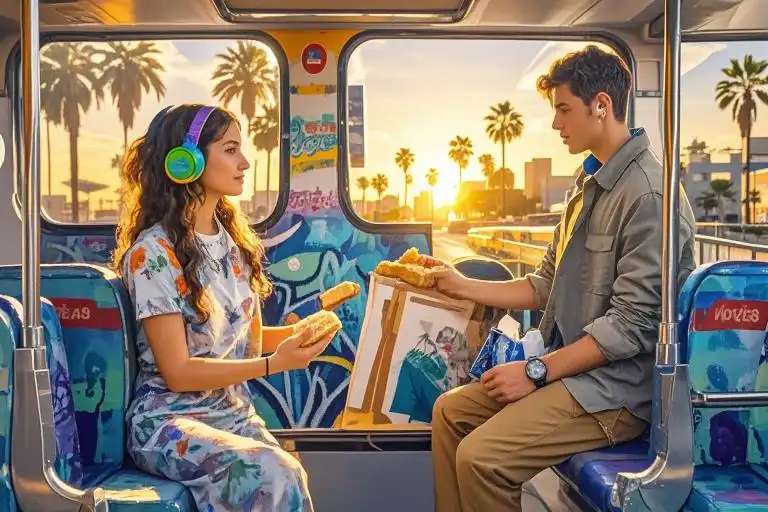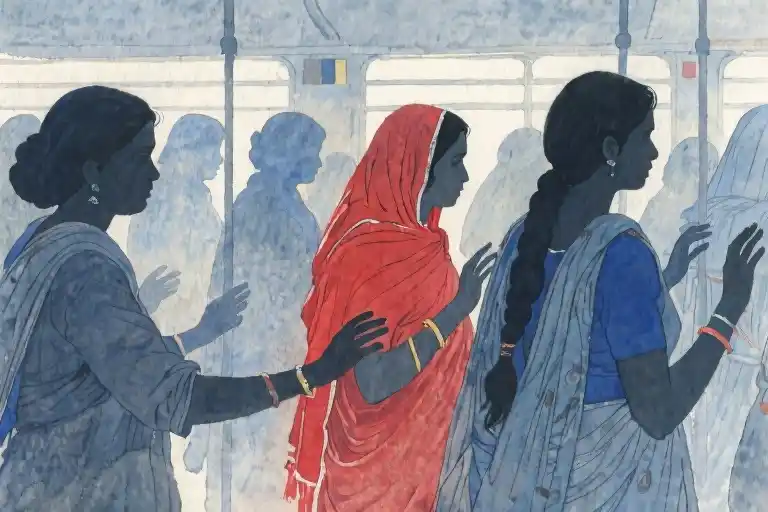The digital clock in the cab glowed 2:19 AM as palm trees of Vasant Kunj blurred past rain-streaked windows. My friend’s manicured nails suddenly bit into my forearm with silent urgency – behind us, the security checkpoint of Delhi’s posh neighborhood still glowed green, while ahead, our entire sense of safety now hinged on the stranger’s profile reflected in the rearview mirror.
That surreal moment crystallizes the paradox of women’s safety in urban India. Here we were, two mildly intoxicated journalists leaving a friend’s party in what property brochures call “Delhi’s safest enclave,” yet our bodies had instinctively shifted to high alert the moment the cab door clicked shut. The AC’s mechanical hum couldn’t mask the tension as my friend’s gaze remained locked on the glove compartment, her nervous system conducting threat assessments no man would recognize.
“Think about it,” she said too brightly, her voice performing calmness like a journalist moderating a panel, “how epically stupid would someone have to be to attack us? Our bylines would turn the assault into breaking news before the ambulance arrived.” Her dark humor carried the unspoken truth – we were simultaneously calculating escape routes and mentally drafting our own crime reports. That’s the cognitive load women carry during every nighttime cab ride in Delhi, where safety checkpoints create illusions of protection while actual security depends on psychological armor.
The taxi’s leather seats stuck to my thighs as we passed another brightly lit police booth, its occupants visible through the window scrolling phones. My friend’s theatrical monologue continued – something about how the judicial system would “destroy future generations” of any assailant – but her left hand kept creeping toward the door release. Outside, the manicured lawns of Vasant Kunj’s gated communities rolled by like a real estate developer’s promise, their high walls failing to ease the primal awareness that our vulnerability traveled with us.
Raindrops streaked diagonally across the window, distorting the streetlights into watery constellations. I caught our driver’s eyes flicking up to the mirror again, and in that heartbeat before his gaze slid away, I understood why women’s safety tips in Delhi so often include “maintain eye contact” – not as aggression, but as a silent ledger keeping count. The cab’s partition glass, installed after the 2012 gang rape case, reflected our tense smiles back at us like funhouse mirrors. Safety features become psychological props when you’re hyperaware that most gender violence here occurs between sunset and sunrise, often in moving vehicles.
As we turned onto my street, the tension didn’t dissipate but rather changed shape – now we were calculating whether to thank the driver normally (risking engagement) or exit wordlessly (appearing rude). My friend’s earlier bravado about judicial consequences couldn’t mask the reality we both knew: for all of Delhi’s post-2012 reforms, women still navigate the city like amateur criminologists, reading threat potential into rearview mirror glances and glove compartments. The security booth’s green light in our rear window faded as we overtipped and scrambled out, our relieved laughter masking the grim understanding that tomorrow’s ride would require the same exhausting vigilance.
The Sobering Moment: Survival Algorithms in a Delhi Cab
The laughter from our friend’s party still echoed in my ears as we stepped into the cab at 2:19 AM. Just minutes ago, we were carefree, mildly intoxicated from shared drinks and stories in that safe suburban home on Delhi’s outskirts. The transition from that warmth to the sudden chill inside the vehicle happened in a heartbeat – one moment giggling about work gossip, the next holding our breath as the cab door clicked shut behind us.
My friend’s body went rigid the moment we settled into the backseat. In the dim glow of passing streetlights, I saw her eyes lock onto the glove compartment with laser focus. Every woman in Delhi knows that look – the hyperawareness that transforms ordinary objects into potential threats. The way her fingers dug into my arm communicated more than words ever could; we’d both activated our internal threat assessment systems.
‘Wouldn’t it be completely ridiculous if someone attacked us?’ she suddenly announced, her voice artificially bright. ‘I mean, we’re journalists. Our disappearance would make headlines by morning.’ The cab driver’s shoulders tensed slightly in the front seat. She continued, louder now, ‘Murder? That’s career suicide. Our crime desk colleagues would hunt them down, and the courts? They’d make an example out of them.’
There was something darkly comedic about listing these hypothetical consequences like we were negotiating with an unseen predator. We both knew this script – the unspoken performance female passengers across Delhi enact nightly. Mention your social connections. Cite institutional consequences. Project confidence even when your pulse races. It’s psychological judo, using the weight of societal systems as leverage against potential threats.
Through the rearview mirror, I caught glimpses of the driver’s eyes flicking between the road and us. The air conditioning hummed too loudly, masking whatever sounds might have warned us of danger. My friend kept talking – about press credentials, about editors expecting our safe return, about how modern technology makes crimes harder to hide. Each statement served dual purposes: reassurance for us, deterrence for him.
This is what urban survival looks like for women in Delhi after dark. Not dramatic confrontations, but these quiet calculations. Not weapons drawn, but social armor deployed. The cab became a moving classroom where we demonstrated how quickly intoxication evaporates when survival instincts take over, how professional identities transform into shields, and how humor can be both coping mechanism and defensive tactic.
As we passed through Vasant Kunj’s gated checkpoints – those supposed guarantees of safety – the irony wasn’t lost on us. The security guards waved us through without a second glance, oblivious to the micro-drama unfolding in the passing vehicle. Outside, the posh neighborhood slept peacefully behind its high walls. Inside our cab, two women remained wide awake, reading meaning into every turn signal and cleared throat, practicing the oldest urban survival skill of all: anticipating danger before it announces itself.
The Math Behind “Safe” Neighborhoods
That night in Vasant Kunj taught me a brutal lesson: safety statistics look very different when you’re staring at a stranger’s rearview mirror. Our cab crawled past manicured roundabouts with security booths every 500 meters – the kind of infrastructure that makes realtors boast about 24/7 surveillance. Yet my friend’s fingernails kept digging crescent moons into my palm.
The Numbers They Don’t Show
Delhi Police data reveals Vasant Kunj reports only 2-3 street harassment cases monthly. Sounds reassuring until you notice the pattern: 83% occur between 10PM-4AM near poorly lit service lanes (the exact route our driver chose). Those decorative CCTV cameras? Most face main roads, leaving elevator lobbies and parking ramps in blind spots big enough to swallow screams.
A resident group’s crowdsourced map shows darker truths:
- Checkpoint Gaps: Security guards change shifts at 2:30AM – our cab passed Sector C checkpoint at 2:28
- Lighting Loopholes: 40% of “well-lit” areas use bulbs below mandated wattage
- Response Times: Even in this “VIP zone”, average police arrival takes 14 minutes
Brochures vs Reality
Compare two versions of Vasant Kunj:
Developer Pamphlets Promise:
- Gated communities with biometric access
- Patrol vehicles every 15 minutes
- Emergency call boxes every 200m
Women Residents Report:
- Biometric systems often disabled for delivery staff
- Patrols avoid interior lanes after midnight
- 60% of call boxes route to understaffed security desks
As we turned onto my street, I finally understood why my neighbor keeps pepper spray clipped to her grocery tote – no amount of marble lobbies can erase the calculus of fear. That “posh” label just means our trauma would trend longer on Twitter.
The Illusion of Surveillance
Those glowing security booths? Many just house sleepy guards watching cricket highlights. A 2021 audit found:
- 70% of cameras in premium neighborhoods lack night vision
- Only 1 in 5 checkpoints actually verify passenger IDs after dark
- Most “24/7 monitored” signs refer to off-site contractors reviewing footage weekly
Yet developers keep advertising “foolproof security” – because nothing sells luxury apartments like manufactured safety. Our cab ride proved even golden cages have rusty locks.
Next: When words become your best weapon – psychological self-defense for urban women
When Words Are Sharper Than Pepper Spray
That night in the cab taught me more about self-defense than any safety workshop ever could. As women in Delhi, we carry invisible armor—not just pepper sprays or emergency apps, but psychological tactics honed through collective urban survival wisdom. Here’s what actually works when you’re alone with your fear and a stranger’s unpredictable intentions.
The Journalist Card: Your Verbal Shield
“My editor expects this recording by 3 AM”—this single sentence changed the energy in that taxi more effectively than screaming ever could. When my friend announced our profession to the driver, she wasn’t just making conversation. She was strategically:
- Establishing accountability (multiple people expecting our arrival)
- Implying evidence trail (mention of recording equipment)
- Invoking institutional power (media organizations have legal teams)
Try adapting this to your own profession:
- Corporate workers: “Our security team tracks all employee cabs in real-time”
- Students: “My professor asked me to share my live location for this night project”
- Freelancers: “Client requires GPS verification before approving travel expenses”
The key isn’t truthfulness—it’s creating perceived consequences in the attacker’s mind.
The Triple-Layer Safety Net
- Active Layer: Share live location with 3+ contacts using apps like Google Maps or WhatsApp (bonus: set automated “check-in” reminders)
- Passive Layer: Register your ride with neighborhood security if available (many gated communities offer this)
- Decoy Layer: Program your phone’s emergency button to send pre-written alerts (e.g., “Cab number DL1CAB1234 diverting from route—call police immediately”)
Pro tip: Create code words with trusted contacts. “Did you feed the cat?” could mean “I feel unsafe but can’t speak openly.”
Legal Self-Defense Tools in India
While we mentally rehearsed escape scenarios, my friend’s hand kept brushing her bag where she kept:
- Legal pepper spray: Must be ≤50ml and labeled “for self-defense only” (avoid imported variants requiring license)
- Flashlight with strobe function: More socially acceptable than weapons, yet disorienting enough to create escape windows
- Whistle app: Some Indian states consider loud noise complaints valid grounds for police intervention
Remember: Even permitted items become illegal if used offensively. The moment an attacker retreats, your legal advantage disappears.
The Psychology Behind Effective Deterrence
That night’s “our murder would make headlines” conversation worked because it targeted three criminal decision-making factors:
- Cost-benefit analysis (media attention = higher conviction chances)
- Social capital loss (“future generations destroyed” narrative)
- Escalation fear (implied that we’d already taken preventive measures)
This explains why vague threats (“I’ll call police!”) often fail—they lack specific, credible consequences. Effective deterrence paints vivid mental pictures of the attacker’s downfall.
Practice Makes Prepared
We now do monthly “safety drills” where we:
- Role-play conversations with hypothetical drivers/attackers
- Test emergency features on new apps together
- Exchange notes on evolving predatory tactics (e.g., recent fake ride-sharing scams)
Because in Delhi after dark, your best weapon isn’t in your purse—it’s in your ability to think like both a potential victim and a journalist documenting the crime before it happens.
The Society in the Rearview Mirror: The Pricing and Failure of Safety
When Justice Reforms Become Psychological Placebos
The 2012 Delhi gang rape case was supposed to change everything. Ten years later, as our cab’s meter ticks past ₹250 in Vasant Kunj, I count the streetlights that still flicker near the gated communities – the same ones that promised ’24/7 monitored safety’ in their brochures. The judicial system did respond: faster track courts, harsher punishments, even death penalties. But in this moving metal box, with my friend’s grip tightening every time the driver adjusts his mirror, those reforms feel as distant as the stars we can’t see through Delhi’s smog.
The Middle-Class Safety Illusion
We’ve all bought into it – the security cameras, the gaurd-patrolled lanes, the premium we pay for addresses that promise protection. Yet here we are, two educated women with iPhones and pepper sprays, calculating whether mentioning our press credentials makes us more or less vulnerable. The cruel joke? Our ₹15,000/month apartment complex has better lighting than the police station 800 meters away. Safety in Delhi isn’t a right; it’s a subscription service that still buffers when you need it most.
The Taximeter of Terror
There’s an unspoken algorithm every Delhi woman knows:
- ₹0-150: Normal vigilance
- ₹150-300: Fingers on emergency contacts
- ₹300+: Active threat assessment
As we pass the ₹320 mark, my friend ‘accidentally’ drops her press ID. The driver sees the logo. His eyes dart away faster than ours did from the glove compartment. For this moment, the system works – not because of laws, but because he believes we might expose him. That’s the real currency of women’s safety in India: not justice, but the perception of consequences.
The Safety Consumers
We’ve become experts at safety theater – the GPS sharing, the fake phone calls, the strategic outfit choices. Developers sell us ‘secure neighborhoods’, apps sell ‘panic buttons’, and we keep buying because the alternative is admitting no product can fix this. The cab’s AC blows cold as we pass another luxury high-rise with ‘women’s safety’ in its amenities list, right between the swimming pool and dog park.
The Unreported 99%
The meter stops at ₹370. We tip ₹30 – not for service, but so he remembers us as generous, not threatening. As the taillights disappear, my friend texts our editor: ‘Reached safe.’ Neither of us mentions the 37-minute performance we just staged. Tomorrow’s headlines will debate another rape case, another policy failure. Meanwhile, millions of women will conduct their own silent risk assessments in cabs, on streets, in what we’re told are ‘safe spaces’. The real crime statistics aren’t in police files; they’re in the WhatsApp groups where we share cab numbers and the unspoken relief when a ride ends uneventfully.
Safety Paradox: The more precautions we take, the less safe we feel – because each measure reminds us the danger exists.
3 Things This Ride Taught Me About Women’s Safety in Delhi:
- Judicial deterrence only works if criminals believe they’ll get caught – most gamble they won’t
- ‘Premium security’ is often infrastructure theater – gates don’t stop determined predators
- Our best defense is making our visibility outweigh our vulnerability – whether through press badges or loud phone calls
As my apartment door locks behind us, I realize: we didn’t escape danger tonight – we just confirmed our ability to navigate it. Again. Until next time.
The Aftermath: When the Night Doesn’t End at Sunrise
As the elevator doors finally closed behind us, my friend and I exchanged a shaky high-five that felt more like surviving a warzone than returning from a dinner party. That cab ride had transformed into something far more significant – a microcosm of what it means to navigate womanhood in urban India. There were no casualties in this particular survival drill, yet the absence of victory weighed heavier than any celebration.
The Unwritten Rules of Delhi Nights
What stayed with me long after that night wasn’t just the fear, but the practical wisdom passed between women like secret knowledge. Here are three field-tested safety protocols refined by Delhi’s women through collective experience:
- The Triple-Layer Contact System
- Share live GPS with one trusted contact
- Set up coded messages (e.g., “Did mom take her medicine?” means “I feel unsafe”)
- Establish check-in times with consequences (“If I don’t text by 3AM, call these numbers”)
- Professional Armor Tactics
- Casually mention workplace connections (“My editor expects this recording”)
- Reference ongoing coverage of similar cases
- Use industry jargon to suggest institutional backing
- Environmental Awareness Hacks
- Note vehicle details aloud (“DL4CAB1234, right driver?”)
- Pretend to recognize locations (“My cousin lives near this petrol station”)
- Keep hands visible while appearing to film street signs
The Psychological Aftermath
That evening revealed an uncomfortable truth about women’s safety in Delhi – the precautions don’t stop when the danger passes. For days afterward, I found myself:
- Replaying the cab ride with “what if” scenarios
- Researching self-defense laws I’d never actually use
- Feeling irrational guilt about nighttime mobility
- Simultaneously resenting and relying on male escorts
Redefining Safety Together
Perhaps the most valuable lesson emerged in our post-mortem analysis over chai the next morning. Real safety isn’t about individual vigilance alone – it’s about:
- Community Infrastructure: Building neighborhood watch networks among female residents
- Professional Solidarity: Creating media industry protocols for threatening situations
- Technological Solutions: Developing panic buttons integrated with ride-sharing apps
As journalists, we recognized our privilege in having platforms to amplify these conversations. But true change requires moving beyond storytelling into systemic action – because no woman should need a press card to feel safe going home at night.





